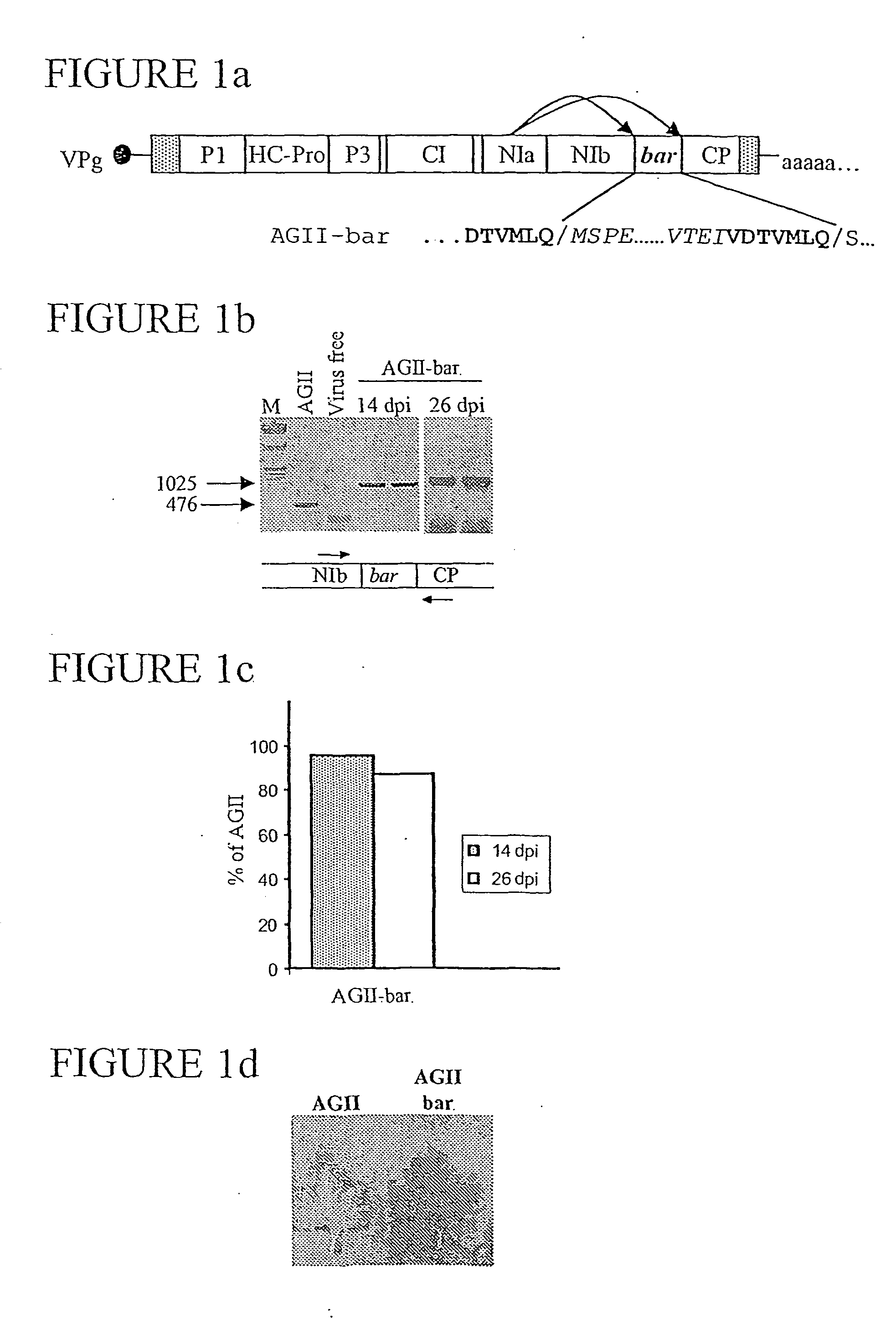Vectors capable of imparting herbicide resistance and viral cross protection and methods
a technology of viral cross protection and vectors, applied in the field of nuclear acid vectors capable of imparting herbicide resistance and viral cross protection, can solve the problems of patents that do not teach the introduction of herbicide resistance genes into plants, and infeasibility of commercial agriculture using whitham teachings, etc., to achieve significant reduction of production costs, increase crop yield, and reduce production costs
- Summary
- Abstract
- Description
- Claims
- Application Information
AI Technical Summary
Benefits of technology
Problems solved by technology
Method used
Image
Examples
example 1
Construction of the AGII-Bar Vector
[0058] In order to express the phosphinothricin acetyltransferase gene (hereinafter bar gene; SEQ ID NO.: 1) in the AGII virus-vector, the gene was inserted between the NIb (Genbank accession number L29569) and CP (SEQ ID NO.: 2) genes using a polylinker-cloning site next to the NIa proteinase cleavage site in the NIb 3′ end of AGII (FIG. 1a). The inserted gene was designed to create an in-frame translational fusion with the flanking NIa processing sites. Proteolysis of the nascent AGII-Bar polyprotein by NIa protease in trans was predicted to yield the bar gene product (SEQ ID NO.: 6) with seven additional amino acid residues (VDTVMLQ) at its C′-terminus (FIG. 1a; SEQ ID NO.: 6).
example 2
Assay of Infectivity of the AGII-Bar Vector
[0059] AGII-Bar was 100% infectious on susceptible squash. Symptoms appeared 7-8 days post-inoculation (dpi) with similar characteristics to those of the parental AGII virus. Squash was employed as the test plant because it is the only cucurbit in which the attenuated AGII symptoms are visible. No symptoms at all are seen on cucumber, melon, pumpkin and watermelon. AGII symptoms in squash include slight vein clearing in young leaves and light patches on older leaves. Slight dark patches appear on fruit of light colored varieties of squash. No deformation or filiform leaf appearance characteristic of the wild type ZYMV are visible. Wild type ZYMV infected plants are highly deformed in leaf and fruit, foliar symptoms consisting of a prominent yellow mosaic, necrosis, distortion, and stunting. Fruits remain small, greatly malformed, and green mottled causing total loss of yield.
[0060] In sharp contrast, AGII infected plants, whether carrying...
example 3
Induction of Gluofosinate Ammonium (Basta) Resistance in Curcurbit Species Using the Vector
[0062] The biological activity of the bar gene product translated from the inoculated vector was tested in the greenhouse. Various concentrations of the glufosinate ammonium based herbicide Basta (Hoechst-Schering AgrEvo, Berlin, Germany) were applied to foliage of squash plants mechanically inoculated with AGII or AGII-Bar from second-generation infected plants. 26 dpi, plants were sprayed till runoff with Basta. All sprayed AGII inoculated plants developed widespread necrosis and died in less than 48 Hrs including plants sprayed with the lowest dose used, 0.125% (Table 1). In contrast, all AGII-Bar plants survived and no necrosis was observed on young and newly emerged leaves even at the highest concentration, 1.0% (Table 1). A representative squash plant is shown in FIG. 2a.
[0063] Some herbicide mediated necrosis was observed, mainly on cotyledons and on the first 2-3 leaves, and was posi...
PUM
| Property | Measurement | Unit |
|---|---|---|
| Fraction | aaaaa | aaaaa |
| Fraction | aaaaa | aaaaa |
| Fraction | aaaaa | aaaaa |
Abstract
Description
Claims
Application Information
 Login to View More
Login to View More - R&D
- Intellectual Property
- Life Sciences
- Materials
- Tech Scout
- Unparalleled Data Quality
- Higher Quality Content
- 60% Fewer Hallucinations
Browse by: Latest US Patents, China's latest patents, Technical Efficacy Thesaurus, Application Domain, Technology Topic, Popular Technical Reports.
© 2025 PatSnap. All rights reserved.Legal|Privacy policy|Modern Slavery Act Transparency Statement|Sitemap|About US| Contact US: help@patsnap.com



